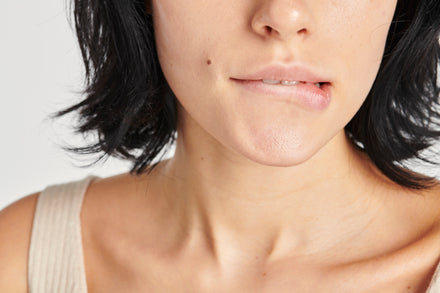During my first year of grad school, I suffered from a life-threatening case of anorexia nervosa. My hair was falling out, my blood pressure was dangerously low, and most importantly: I hadn’t gotten my period in almost a year. After nearly fainting trying to get out of bed one morning, I went straight to a local health center. I couldn’t do this to myself anymore — I needed help from a professional.
My doctor congratulated me on my weight loss. When I said I wasn’t eating and expressed fear about not menstruating for several months, he told me I was probably pregnant. I let him know this was impossible: I hadn’t been sexually active in three years.
He laughed, patted my knee, and told me that I didn’t have to tell him the truth.
I left, completely discouraged—and a bit insulted. Am I wrong? Is everything actually fine? Am I being dramatic?
Within a few Google searches at home, I learned that I’d been right to voice my concerns: my anorexia had resulted in hypothalamic amenorrhea, or the absence of menstruation due to restriction. I’d thrown my body into adrenal crisis, and it was shutting down all non-essential functions to keep me alive — including my reproductive system. Eleven months later, during my recovery, I found out from a different physician that I had narrowly escaped lifelong heart and reproductive issues.
My first doctor hadn’t listened to me. In fact, he accused me of lying—and I wasn’t surprised. Because as a woman, particularly a Black woman, I know that it’s statistically unlikely that I’ll be taken seriously in a medical emergency.
Anecdotes like mine aren’t unfamiliar among women, and they’re just a small part of the overwhelming evidence pointing to one fact: there’s something seriously wrong with women’s healthcare. Here are a few key issues the data shows us — and what some of the reasons are.
Too many doctors aren’t listening to women.
According to the Kaiser Family Foundation, nearly 50% of women between ages 18 and 35 had a negative experience with a healthcare professional. Of all women surveyed, 20 percent said their doctor made assumptions about them and their health without asking—and 15 percent said that their provider accused them of not being truthful about their health.
In 2023, Forbes Health reported on a college student who tore a ligament and damaged her kneecap. When she reported the incident to her doctor, she was dismissed and told to walk it off and exercise more. Yep, you read that right: this patient was told to walk off a major ligament tear in her knee. Per the New York Times, a female doctor once went to her own physician with concerns about sudden weight loss, and was told she must simply be on a diet. In reality, a serious illness in her medical history was recurring. And in 2015, a Seattle neurologist had to fight tooth and nail for her doctors to scan her brain for months, after experiencing a pounding headache. The scans revealed she had a large brain tumor.
Self-advocacy is important for every patient seeking healthcare—but for women, the summit is twice as high and doubly dire. Female hysteria, a since-debunked condition, was an extremely popular catch-all diagnosis for women in the 19th century with depression, increased sex drive, or frankly any ‘undesirable behavior.’ While the condition is now recognized as a load of hooey, the stigma of women simply being hysterical or “dramatic” clearly hasn’t gone away.
Pain bias is real, particularly for Black women and women of color.
“Oh, it can’t be that bad!” is a familiar, nagging chorus to many women. The data shows that chorus is even louder in the medical world: on average, women wait 15 minutes longer to be seen in emergency rooms than men with the exact same symptoms. When women and men complain of the exact same pain levels, doctors are more likely to prescribe women sedatives and anti-anxiety medication, rather than painkillers.
Harvard Health and BBC found that the majority of clinical research on pain utilizes male, or rodent, subjects—and often excludes women entirely. Women’s pain is rarely believed—and even more rarely studied.
Experts call this type of discrimination pain bias—and it’s incredibly dangerous. 70% of people that experience chronic pain are women, and being undermedicated for consistent pain not only disrupts quality of life, but worsens health. Pain is also a critical indicator for life-threatening events like heart attacks, strokes, pulmonary embolisms, and more. Minimizing women’s pain means that these severe conditions can go unnoticed for far too long—and when a minute can be the difference between life or death, this is a fatal oversight. Don’t believe us? This study found that women are seven times more likely than men to be sent home in the midst of a heart attack.
The situation only worsens for BIPOC, particularly Black, women. An alarming landmark study conducted in 2016 found that Black Americans are “systemically undertreated for pain,” with a majority of surveyed clinicians revealing that they did not believe that Black patients experienced as much pain as their white counterparts. So, with healthcare providers finding women’s pain to be exaggerated, and Black patients’ pain to be nonexistent, Black women are doubly ignored, dismissed, and gaslit in medical spaces. Celebrity status doesn’t shield any Black woman from this reality, either: Serena Williams is living proof.
Women’s healthcare is underfunded.
If we’re putting our money where our mouths are, the financial investment in women’s health doesn’t say much. A study published in the National Library of Medicine found that the allocation of medical research funding slants heavily towards men’s health—diseases and conditions that affect men receive far more funding than those that affect women. The Journal of American Medicine arrived at similar findings in their 2019 research letter: female clinical researchers receive 26.7% less grant funding than their male counterparts—and in many cases, are less likely to receive federal funding and grants, including from the National Institute of Health. And while the majority of the healthcare workforce identifies as female, additional research found that women who chose to work in healthcare are often siloed into non-physician and specialist roles, despite their interests—and are offered lower salaries. So, if women working in healthcare aren’t even getting the support they need, where could that possibly leave women seeking care?
It’s easy to feel hopeless looking at the state of women’s health, and if you’re a patient, it’s not (and will never be) your job to fix a broken system. That said, here are some things that might make your next visit a little easier:
- If you can, find a provider that advocates for women’s health and shares your values—and if you’re a woman of color or Black woman, consider finding one that shares your identity.
- Document everything when it comes to your health care appointments.
- Speak up for yourself and correct any assumptions—you know your body best.
- Don’t be afraid to get a second (or third!) opinion. It might not feel like much, but it’s a small step towards ensuring your voice is heard.











